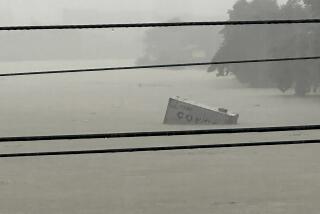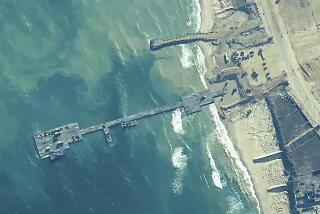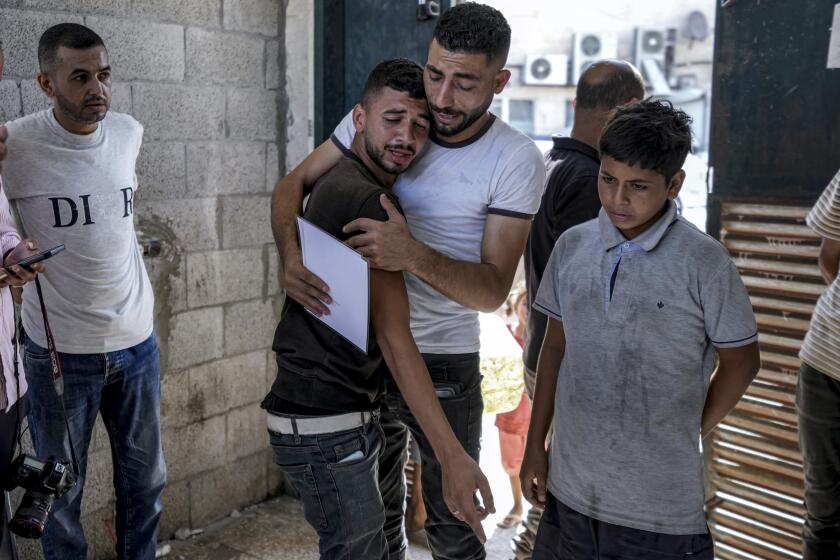Philippine typhoon aid delivery picks up speed
CEBU, Philippines — With pressure mounting to speed up the distribution of aid to victims of Typhoon Haiyan, the U.S. aircraft carrier George Washington and its strike group arrived Thursday in the Philippines, and officials said relief flights could take place around the clock at two airports.
Rear Adm. Mark Montgomery, commander of the George Washington Strike Group, said the carrier and cruisers Antietam and Cowpens would take up positions off the east coast of Samar island “to begin to assess the damage and to provide logistical and emergency support, including medical care and water supplies,” according to a Pentagon news release.
The Navy cargo ship Charles Drew transported more than 1,900 gallons of water and food to an airfield in the hard-hit city of Tacloban, on Leyte island, which bore the brunt of the monster storm that ripped through the central Philippines late last week, and will move food and water to Guiuan airfield in Samar province, the Pentagon said.
PHOTOS: Central Philippines devastated by Typhoon Haiyan
More than 20 U.S. helicopters will ferry supplies ashore and take badly injured people to the George Washington for medical care. Pilots flew some of the planes from the carrier to a U.S. naval air station in Japan to create more room on the flight deck for helicopter operations.
“These helicopters represent a good deal of lift to move emergency supplies around,” Montgomery said.
The destroyer Mustin is heading to Ormoc, a port city in Leyte province that is a third focus for relief operations, in addition to Tacloban and Samar.
At a military air base in the city of Cebu, which serves as the hub for relief efforts, officials said night flights had begun in Tacloban and were also possible at the Guiuan airfield, a logistics center on Samar. Flights had been limited to daytime because of insufficient lighting and personnel to operate at night.
Cebu’s airport was a hive of activity Thursday, as cargo planes took off carrying supplies and personnel from countries such as Israel, Indonesia and Taiwan and returned with some of the desperate people who line up every day in Tacloban to try to get a flight out of the disaster zone.
“The operations tempo is increasing,” said Lt. Gen. Roy Deveraturda, who heads the Philippine armed forces central command. “We have airlifted and delivered more than 1.8 million pounds of relief goods, food, water and medicine.”
Fourteen Red Cross trucks arrived in Tacloban on Thursday, he said. But many remote areas had yet to see any of the boxes that were piling up at the airfield. Roads were still being cleared of debris, more helicopters were needed and severed communications was making it difficult to coordinate deliveries with local leaders, officials said.
The official death toll from the typhoon, known by Filipinos as Yolanda, stood at 2,357, but humanitarian workers said the figure could grow. The United Nations Office for the Coordination of Humanitarian Affairs said the storm had killed 4,460 people.
The Philippines News Agency said Chief Supt. Elmer Soria, a police official who had told reporters that the death toll might reach 10,000 people, “was relieved from his post.”
The U.N. estimates that 11.8 million people have been affected by the typhoon, with hundreds of thousands left homeless.
Decaying bodies were still in the streets in Tacloban six days after the storm hit. The city held its first mass burial Thursday for scores of victims.
U.N. humanitarian chief Valerie Amos, who toured the city Wednesday, said tens of thousands of people were living in the open, exposed to the rain and wind.
“The situation is dismal,” she told reporters in the capital, Manila, on Thursday, the Associated Press reported. “I think we are all extremely distressed that this is Day 6 and we have not managed to reach everyone.”
Meanwhile, the Chinese government, which came under fire at home and abroad for initially providing $100,000 for typhoon relief, said it was contributing money and aid worth $1.64 million.
The lower assistance figure from Beijing was seen as a reflection of a continuing territorial spat between the two countries over islands and reefs in the South China Sea.
“The Chinese are a nation who have a lot of sympathy, a people who love peace, who are happy to do good deeds,” Foreign Ministry spokesman Qin Gang said at a news briefing Thursday in Beijing. “I believe that the vast majority of the Chinese people are understanding and sympathetic toward the situation of the Philippine people.”
The Chinese Red Cross is also providing $100,000.
Jonathan Pollack, an Asia scholar at the Brookings Institution, said China was missing an opportunity to exercise its “soft power” in the region with its response to the disaster.
“The Chinese dropped the ball,” said Pollack, who was attending a conference in Beijing. “They had the advantage of proximity. They could have offered to send in ships to help and the onus would have been on the Philippines to accept or reject it.”
Times staff writers Barbara Demick in Beijing and David S. Cloud in Washington contributed to this report.
More to Read
Sign up for Essential California
The most important California stories and recommendations in your inbox every morning.
You may occasionally receive promotional content from the Los Angeles Times.









